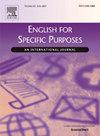Lexical coverage in science popularization discourse: The case of popular science news from Scientific American
IF 2.7
1区 文学
Q1 LINGUISTICS
引用次数: 0
Abstract
Science popularization discourse offers valuable reading materials for second language (L2) learners in English for Academic Purposes (EAP) contexts. However, the lexical demands of these materials remain largely unexplored. To address this gap, this study examines the lexical profile of Scientific American (SA), one of the most widely read popular science publications. Based on a corpus of popular science news collected from the SA website, we analyzed its lexical demand in terms of Nation's (2018) BNC/COCA word frequency lists and West's (1953) General Service List of English Words (GSL) plus Coxhead's (2000) Academic Word List (AWL). Our results indicate that to achieve minimal comprehension of popular science news published in SA, learners should be familiar with approximately 5,000 word families, while optimal comprehension requires knowledge of around 10,000 word families, including proper nouns, marginal words, transparent compounds, and acronyms. Notably, the GSL covers 77.55% and the AWL covers 7.08% coverage of the SA corpus, suggesting that our SA corpus has a higher coverage of general English words and a lower coverage of academic English words than university-level academic written texts. These findings highlight the potential value of popular science news in supporting academic reading, particularly for beginning EAP learners who may find these materials less lexically demanding than research articles. Pedagogical implications for incorporating popular science news into EAP courses are also provided.
科学普及话语中的词汇覆盖:科学美国人》的科普新闻案例
科学普及话语为学术英语(EAP)语境中的第二语言(L2)学习者提供了宝贵的阅读材料。然而,这些材料的词汇需求在很大程度上仍未得到探讨。为了填补这一空白,本研究考察了《科学美国人》(SA)的词汇概况,它是阅读量最大的科普出版物之一。基于从《科学美国人》网站收集的科普新闻语料库,我们根据 Nation(2018 年)的 BNC/COCA 词频表和 West(1953 年)的英语词汇通用服务表(GSL)以及 Coxhead(2000 年)的学术词汇表(AWL)分析了其词汇需求。我们的研究结果表明,要达到对南澳大利亚州发布的科普新闻的最低理解能力,学习者应熟悉约 5,000 个词族,而最佳理解能力则需要了解约 10,000 个词族,包括专有名词、边缘词、透明化合物和缩略语。值得注意的是,在 SA 语料库中,GSL 的覆盖率为 77.55%,AWL 的覆盖率为 7.08%,这表明我们的 SA 语料库与大学学术书面文本相比,普通英语词汇的覆盖率较高,而学术英语词汇的覆盖率较低。这些发现凸显了科普新闻在支持学术阅读方面的潜在价值,特别是对于初学 EAP 的学习者来说,他们可能会发现这些材料对词汇的要求没有研究文章那么高。研究还提供了将科普新闻纳入 EAP 课程的教学意义。
本文章由计算机程序翻译,如有差异,请以英文原文为准。
求助全文
约1分钟内获得全文
求助全文
来源期刊

English for Specific Purposes
LINGUISTICS-
CiteScore
5.70
自引率
8.00%
发文量
41
审稿时长
62 days
期刊介绍:
English For Specific Purposes is an international peer-reviewed journal that welcomes submissions from across the world. Authors are encouraged to submit articles and research/discussion notes on topics relevant to the teaching and learning of discourse for specific communities: academic, occupational, or otherwise specialized. Topics such as the following may be treated from the perspective of English for specific purposes: second language acquisition in specialized contexts, needs assessment, curriculum development and evaluation, materials preparation, discourse analysis, descriptions of specialized varieties of English.
 求助内容:
求助内容: 应助结果提醒方式:
应助结果提醒方式:


